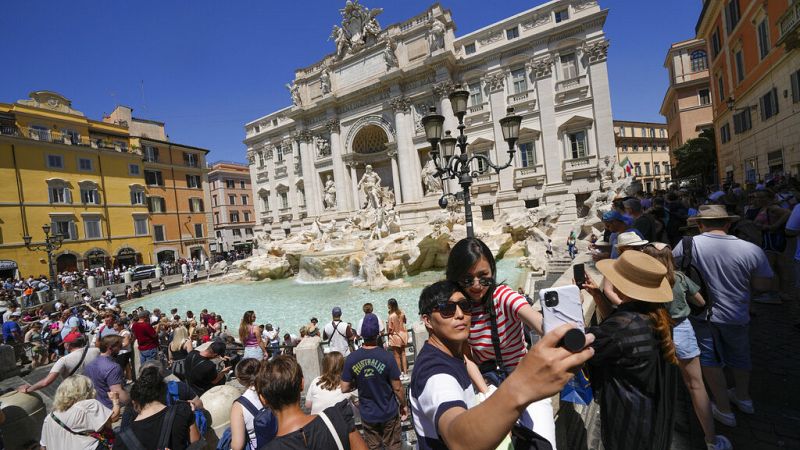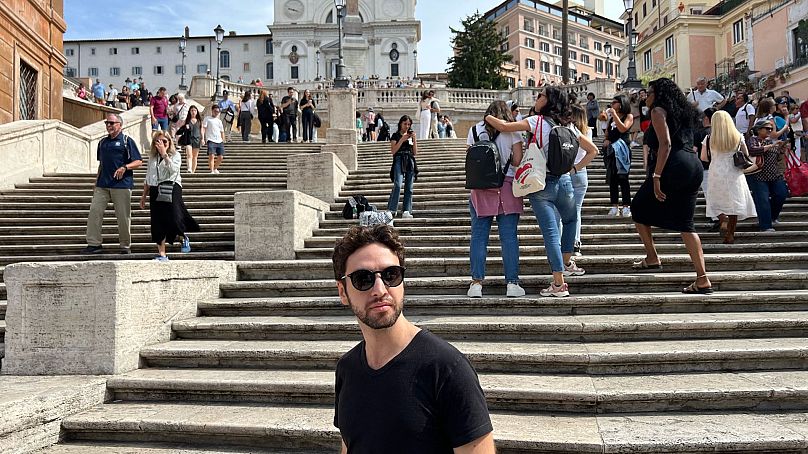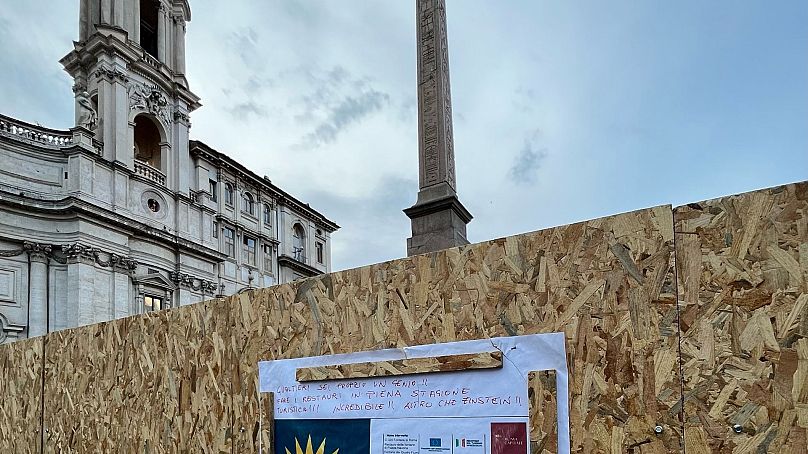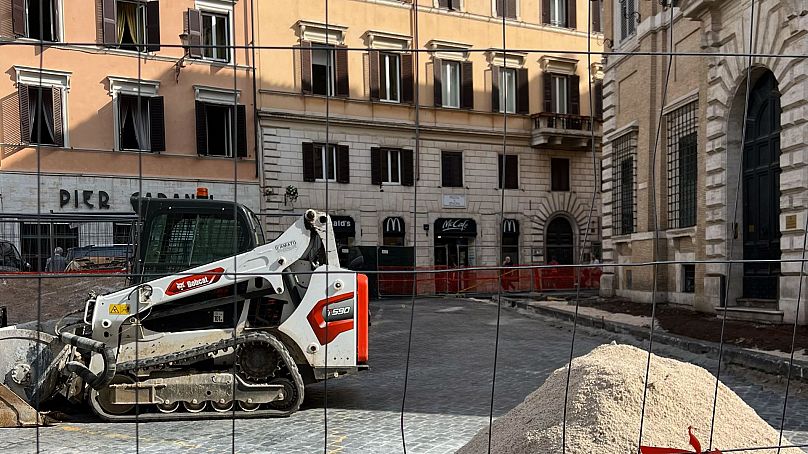‘It’s changing the city’s face’: Locals share stories on how overtourism impacts Rome’s culture

Tourism in Italy has not only recuperated since the COVID-19 lockdown days: visitors are coming back in droves at unprecedented levels, particularly in the Italian capital of Rome.
Last year, a record 35 million people flocked to the Eternal City. And, with the Catholic Church’s Jubilee coming up next year, things are only going to get more intense.
I first moved to Rome back in April 2021, in the midst of COVID-19, to pursue my PhD programme. Back then, the city felt like one of Italian director Federico Fellini’s film sets.
I recount visiting the much-beloved Trevi Fountain in broad daylight, which was so empty you could hear a pin drop.
It was inevitable that things would have changed in due course. Yet little did I expect that, three years later, the situation would become so intolerable that Rome’s local government would mull over charging visitors to see iconic landmarks.
‘Overtourism is a plague’ says Rome resident
As the city plans to start ticketing people to visit Trevi Fountain, residents are wondering if things have gone too far - and if tourism has become more a burden on, rather than bulwark of, the city’s life.
“Overtourism is a plague,” Anthony Majanlahti, a Rome-based professor and one of the leading experts in the city’s history, tells Euronews Travel.
“The proposal to charge a fee [€2] will make foot traffic in the area worse, not better. In fact, it’s just a shameless cash grab.”
“What about the actual city life that goes on in the piazza, the shops and bars there, the church of SS. Vincenzo ed Anastasio on the corner, the city’s oldest pharmacy quietly looking onto the square?” he ponders.
Trevi Fountain is not the only part of the city to have felt tarnished by the ‘reverse’ Midas touch of overtourism. Locals claim that the overcrowded streets are becoming impossible to navigate.
Other common complaints include Airbnbs and holiday rentals driving rent through the roof, public transport turning into an unapproachable odyssey, and excess litter and cleanliness concerns.
Some of the foundations of la dolce vita - the beauty of savouring all the small rituals that make up Italian daily life - have started to feel more like chores.
For instance, I was forced to migrate from my local café because outside chairs and tables are now reserved for ‘[tourist] dining’, and no longer for locals wanting a coffee.
The prices have also been inflated to cater to the market - the days of a €1 espresso are a distant memory.
Rome: A favoured destination for centuries
Tourists have always been part of Rome’s DNA: from the ruin-hopping Anglo-German aristocrats of the ‘Grand Tour’ and pilgrims flocking to St. Peter’s Basilica and other sacred sites to the low-cost, sun-seeking package deal revellers of the post-Second World War period.
Indeed, the very neighbourhood I live in near the Spanish Steps was largely developed in the 18th century to accommodate swelling crowds of pilgrims.
But today’s visitors seem less part of the city’s fabric.
It feels as if Rome’s face is changing to cater to tourists, forgetting its own identity in the process.
‘Overtourism’ or business as usual in Rome? What the numbers say
While the COVID-19 pandemic took an obvious toll on what is one of Italy’s biggest sectors - accounting for 10.5 per cent of its GDP - statistics show that Italy has had no issue recuperating former visitors. If anything, numbers are on the rise.
“Revenge tourism was very real. Visitors came a lot faster and a lot more aggressively than people expected”, says Mitra Talarman, a prolific Rome-based travel guide with an online following of over half a million, when speaking to Euronews Travel.
Much of Rome’s enduring appeal is timeless - from its architectural glories spanning three millennia to its quintessentially romantic charm.
Yet driving the tourist boom is both its recent representation in the international media (most recently, the latest season of the hit Netflix series 'Emily in Paris', which is partially filmed in Rome) and its appearance in videos on social media apps Instagram and TikTok.
But as 32 million individuals are expected to visit Rome solely for its Jubilee year, the city simply isn’t equipped to handle the sheer mass of individuals
“We don’t have enough tour guides, we don’t have enough bus drivers,” Talarman bemoans.
Is the Jubilee turning Rome into a ‘giant Airbnb’?
The Catholic Church’s Jubilee, which will commence Christmas Eve 2024 and last until December 2025, is the next big event in the Roman calendar.
In preparation for the fresh wave of approximately 32 million pilgrims expected to flock to the Roman capital and the Holy See, the town’s administration has embarked upon a mammoth urban renovation and beautification programme.
This has seen roads close, metro stations shut, and landmarks hidden behind scaffolding - much to the chagrin of locals.
Held every 25 years, it’s intended to represent the remission of sins and debts. But locals are far less forgiving.
The Jubilee has, ironically, become so triggering for Roman residents that it has even fuelled the rants of TikTokers.
“After this year, they’ll open a mental asylum for people who live in this city,” says one influencer in a reel posted on Instagram that has already garnered over 300,000 views.
Arguably, the biggest impact the Jubilee has on local life is the housing market.
Tourism’s impact on the global housing crisis or ‘The Airbnb Effect’ has already been well-documented. And, as the world’s seventh most-visited city, Rome is far from exception.
Short-term rentals in the Italian capital increased by 37.3 per cent in 2023, making it the second-highest city in Europe after Amsterdam.
Rent now averages €2,000 a month, while the average monthly salary is €2,367. Finding a single flat for less than €700 in Rome’s suburbs, which are poorly covered by the public transport system, has now turned into a near-impossible challenge.
Journalist Simone Alliva is one individual bearing the brunt of the Jubilee.
Forced to leave his home of 13 years to make way for a new holiday rental, Alliva directly blames the Jubilee - and politicians’ lacklustre response to it - for transforming Italy’s capital into a holiday site that has evicted its own inhabitants.
“The city has turned into a giant Airbnb,” he tells Euronews Travel. “[Rent] has reached astronomical heights: rooms alone are going for €800 a month.”
“Many have been forced to leave the home they’ve lived in for years because their landlord decided to take advantage of this major event for extra profit,” he added.
The situation has reached a boiling point, as students take to the streets to protest their increasingly unaffordable living situation in Rome’s main student neighbourhood (San Lorenzo).
“The city should enact ordinances closing the thousands of Airbnb apartments in the city centre if it wants to take overtourism seriously,” Majanlahti states.
Are there any opportunities in Rome’s overtourism issue?
Some popular tourist spots in Italy have taken matters into their own hands, responding to the issue with controversial measures.
Most famously, Venice implemented a tax for day-trippers, which was met with significant controversy.
However, this is not the position taken by Italy’s current tourism minister, Daniela Santanchè, who earlier this year was investigated for allegedly fraudulent activity. For the ministry, this is business as usual - if not better.
“The Ministry’s policies and strategies are based on the view that growth is not the problem; rather, it is how growth is managed,” she tells Euronews Travel.
When asked how the problem could be managed, the minister mentioned encouraging the diversification of tourist destinations and sustainable practices and allocating €47 million to “strengthen major cultural destinations” like Rome.
No answer is provided regarding the housing crisis and how citizens are being displaced.
“When the Jubilee is finished, what will be left of Rome?” Alliva asks. With the event starting in less than two months, its residents will soon find out.




